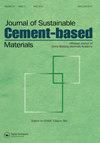Visible light antibacterial potential of graphene-TiO2 cementitious composites for self-sterilization surface
IF 4.2
3区 工程技术
Q1 CONSTRUCTION & BUILDING TECHNOLOGY
Journal of Sustainable Cement-Based Materials
Pub Date : 2022-11-08
DOI:10.1080/21650373.2022.2143451
引用次数: 1
Abstract
Graphene oxide-titanium dioxide (GO-TiO2) composite was synthesized with one step hydrothermal process. The structure and morphology were characterized by field-emission-scanning-electron-microscopy, Thermogravimetric analysis, X-ray diffraction, Fourier transform infrared spectroscopy and X-ray photoelectron spectroscopy. Photocatalytic activity against Escherichia coli inactivation was carried out by GO-TiO2 mixed with cement composite under visible light. The result revealed no significant difference between morphology of GO-TiO2 and pristine TiO2. FESEM and FTIR results showed the presence of carbon component in the GO-TiO2 composites. TGA-IR confirmed that the GO content (3%) in the composite could be controlled during the synthesis process. The synthesized GO-TiO2 had stronger visible light absorption and narrower bandgap (3.11 eV) than TiO2 (3.21 eV). The bandgap reduction was also observed in cement sample with GO-TiO2 (3.08 eV) which could be beneficial for reducing the energy needed for photoexcitation. As a result, the specimen with GO-P25 outperformed specimens with others for Escherichia coli inactivation.石墨烯- tio2胶凝复合材料自杀菌表面的可见光抗菌潜力
采用一步水热法合成了氧化石墨烯-二氧化钛(GO-TiO2)复合材料。通过场发射扫描电子显微镜、热重分析、X射线衍射、傅立叶变换红外光谱和X射线光电子能谱对其结构和形貌进行了表征。GO-TiO2与水泥复合材料在可见光下对大肠杆菌的灭活进行了光催化活性研究。结果表明,GO-TiO2的形态与原始TiO2的形态没有显著差异。FESEM和FTIR结果表明GO-TiO2复合材料中存在碳组分。TGA-IR证实在合成过程中可以控制复合物中的GO含量(3%)。合成的GO-TiO2具有较强的可见光吸收和较窄的带隙(3.11 eV)比TiO2(3.21 eV)。在含有GO-TiO2(3.08 eV),这可能有利于减少光激发所需的能量。结果,GO-P25的样本在大肠杆菌灭活方面优于其他样本。
本文章由计算机程序翻译,如有差异,请以英文原文为准。
求助全文
约1分钟内获得全文
求助全文
来源期刊
CiteScore
6.60
自引率
15.90%
发文量
71
期刊介绍:
The Journal of Sustainable Cement-Based Materials aims to publish theoretical and applied researches on materials, products and structures that incorporate cement. The journal is a forum for discussion of research on manufacture, hydration and performance of cement-based materials; novel experimental techniques; the latest analytical and modelling methods; the examination and the diagnosis of real cement and concrete structures; and the potential for improved cement-based materials. The journal welcomes original research papers, major reviews, rapid communications and selected conference papers. The Journal of Sustainable Cement-Based Materials covers a wide range of topics within its subject category, including but are not limited to: • raw materials and manufacture of cement • mixing, rheology and hydration • admixtures • structural characteristics and performance of cement-based materials • characterisation techniques and modeling • use of fibre in cement based-materials • degradation and repair of cement-based materials • novel testing techniques and applications • waste management

 求助内容:
求助内容: 应助结果提醒方式:
应助结果提醒方式:


